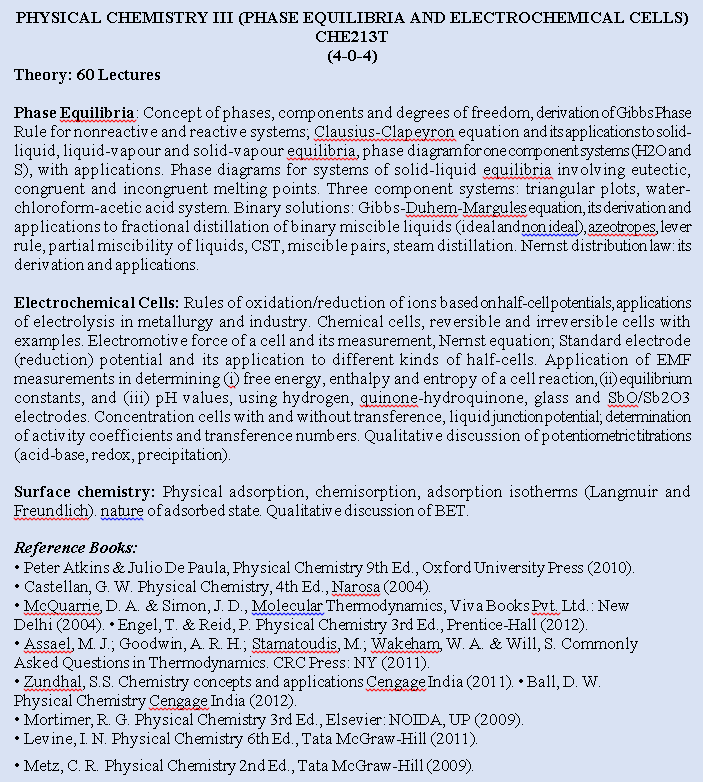
Scope & objective of the course:
This course is mainly based on application part of thermodynamics in phase separated systems and electrochemistry. Surface chemistry is also included that includes basic knowledge of adsorption processes. The course aimed more towards the application part. The students are expected to perform some of the experimental aspects of this course material in their practical laboratories for a better understanding of the subject.
Learning outcome:
Successful students completing the course are able to solve phase change related problems which are advanced applications of thermodynamics. The students will be able to solve problems related to catalysis and apply this knowledge in experimental laboratories or industry based applications to calculate relative efficiency of catalysts. A part of electrochemistry is also taught in this course and a student will be able to construct half-cell reactions and predict direction of a reaction based on electrode potential calculations. Electrochemical cell construction is also a part of the theory and a successful student will be able to calculate the voltage of a cell correctly. This theoretical knowledge can be applied to the experimental laboratory based works also. The internal evaluations are partly based on oral presentations where student develops soft skills throughout the course.
PHYSICAL CHEMISTRY III (PHASE EQUILIBRIA AND ELECTROCHEMICAL CELLS)
CHE213T
(4-0-4)
Theory: 60 Lectures
Phase Equilibria: Concept of phases, components and degrees of freedom, derivation of Gibbs Phase Rule for nonreactive and reactive systems; Clausius-Clapeyron equation and its applications to solid-liquid, liquid-vapour and solid-vapour equilibria, phase diagram for one component systems (H2O and S), with applications. Phase diagrams for systems of solid-liquid equilibria involving eutectic, congruent and incongruent melting points. Three component systems: triangular plots, water-chloroform-acetic acid system. Binary solutions: Gibbs-Duhem-Margules equation, its derivation and applications to fractional distillation of binary miscible liquids (ideal and non ideal), azeotropes, lever rule, partial miscibility of liquids, CST, miscible pairs, steam distillation. Nernst distribution law: its derivation and applications.
Electrochemical Cells: Rules of oxidation/reduction of ions based on half-cell potentials, applications of electrolysis in metallurgy and industry. Chemical cells, reversible and irreversible cells with examples. Electromotive force of a cell and its measurement, Nernst equation; Standard electrode (reduction) potential and its application to different kinds of half-cells. Application of EMF measurements in determining (i) free energy, enthalpy and entropy of a cell reaction, (ii) equilibrium constants, and (iii) pH values, using hydrogen, quinone-hydroquinone, glass and SbO/Sb2O3 electrodes. Concentration cells with and without transference, liquid junction potential; determination of activity coefficients and transference numbers. Qualitative discussion of potentiometric titrations (acid-base, redox, precipitation).
Surface chemistry: Physical adsorption, chemisorption, adsorption isotherms (Langmuir and Freundlich). nature of adsorbed state. Qualitative discussion of BET.
Reference Books:
• Peter Atkins & Julio De Paula, Physical Chemistry 9th Ed., Oxford University Press (2010).
• Castellan, G. W. Physical Chemistry, 4th Ed., Narosa (2004).
• McQuarrie, D. A. & Simon, J. D., Molecular Thermodynamics, Viva Books Pvt. Ltd.: New
Delhi (2004). • Engel, T. & Reid, P. Physical Chemistry 3rd Ed., Prentice-Hall (2012).
• Assael, M. J.; Goodwin, A. R. H.; Stamatoudis, M.; Wakeham, W. A. & Will, S. Commonly
Asked Questions in Thermodynamics. CRC Press: NY (2011).
• Zundhal, S.S. Chemistry concepts and applications Cengage India (2011). • Ball, D. W.
Physical Chemistry Cengage India (2012).
• Mortimer, R. G. Physical Chemistry 3rd Ed., Elsevier: NOIDA, UP (2009).
• Levine, I. N. Physical Chemistry 6th Ed., Tata McGraw-Hill (2011).
• Metz, C. R. Physical Chemistry 2nd Ed., Tata McGraw-Hill (2009).
- Teacher: Soumendra Nath Bandyopadhyay